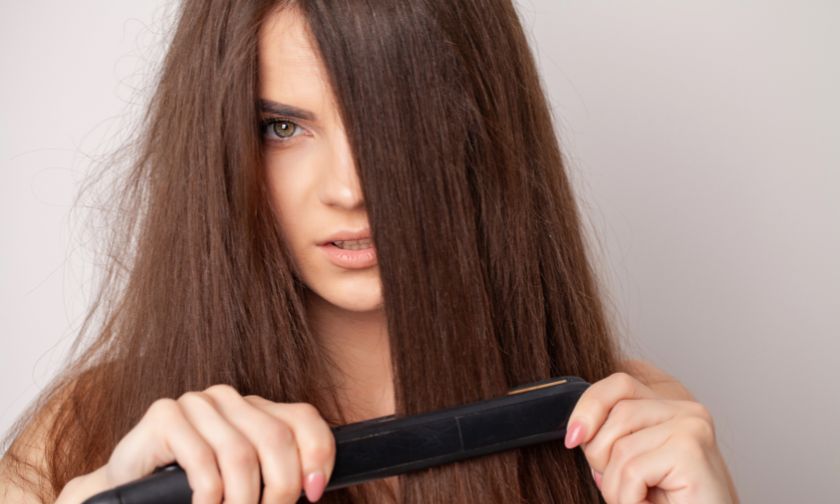If you’re hoping to get that sleek, pin-straight, salon look without heat or chemicals, let’s set the record straight — it’s probably not happening. But that doesn’t mean you’re stuck with frizz or unpredictable waves. There are ways to smooth your hair, reduce puffiness, and create a straighter, more polished look using natural techniques that don’t involve damage.
Over the years, I’ve tested just about everything — from brushing tricks to overnight buns to better hair tools. Some methods helped a little, some did nothing, and a few became part of my regular routine. On workout days when I know I’ll be sweating and showering anyway, I rely on low-effort, no-heat tricks to help my hair dry in a way that looks more put-together. Other times, when I need a bit more, I reach for a tool like the GlamUp 5-in-1 that still smooths without frying my hair.
If you’re tired of choosing between flat irons and flyaways, these are the real methods that can help — and the ones that aren’t worth your time.
Roller Set for Heat-Free Volume and Smoothness
Rollers sound old school, but they’re still one of the gentlest and most effective ways to get smoother, looser hair without using heat. The trick is to use large plastic rollers (not Velcro, not foam — those snag and frizz) on damp, detangled hair, and give it enough time to fully dry while stretched into shape.
If your hair has a slight wave or tends to puff up as it dries, this method can help train it to fall straighter with more polish. Use a light leave-in conditioner or smoothing serum to prep, then roll sections of hair away from your face. Clip them in place and let your hair dry naturally — either during the day if you’re staying home, or overnight with a silk scarf wrapped loosely around your head to keep things neat.
Results will vary depending on your texture, but if you tend to blow-dry your hair anyway, switching to rollers a few days a week can give your strands a much-needed break.
Flat Wrap Technique While You Sleep
This one takes a little practice but can seriously smooth your hair overnight — especially if you’re working with light waves or thick, puffy hair that won’t lay flat on its own.
Start with damp, detangled hair. Using a soft paddle brush, begin brushing sections flat around your head, following a circular pattern. Secure each section with bobby pins as you go, making sure the hair stays stretched and smooth against your scalp. Once it’s all wrapped, cover your head with a silk scarf or bonnet to hold everything in place and prevent frizz from friction.
By morning, your hair will have dried in that stretched shape. The result isn’t glass-flat, but it’s a huge improvement in smoothness and manageability — especially at the roots and crown, where blowouts tend to puff up by day two. It’s also a great overnight reset if you worked out and had to rinse your hair but don’t want to heat-style again.
If you’re like me and still need a tool the next day to finish the ends or tame the back, at least this gives you a better base to start from.
Brush and Air Dry in Short Sessions
If your hair starts to frizz or curl as it dries, brushing it in sections while it air dries can help guide it into a straighter shape — no heat required. This one’s not a miracle solution, but it can make a noticeable difference in how smooth and neat your hair looks when dry.
Start by towel-drying your hair gently (no rough rubbing) and apply a light leave-in conditioner or smoothing cream. Then, every 5 to 10 minutes, section off your hair and brush it straight using a wide paddle brush or a vented detangling brush — something that won’t snag or tug while your hair’s still fragile.
The key is consistency. Brushing once won’t do much, but brushing a few times while it’s drying helps reduce wave formation and tension-drys your hair in a straighter pattern. This is especially helpful for people who don’t want to heat-style daily but still want their hair to air dry in a more polished way.
It won’t replace a blowout, but if you just need to get through a low-maintenance day looking clean and put-together, this works better than letting it dry into a triangle.
Coconut Milk Mask for Smoother Texture
If your hair feels coarse, dry, or puffs up as soon as it air dries, coconut milk can help soften the texture and weigh it down just enough to look smoother. It won’t magically straighten curls, but it’s a natural way to improve shine, reduce frizz, and add flexibility — all of which help hair fall straighter.
To try it, pour full-fat unsweetened coconut milk into a bowl and apply it to damp hair from root to tip. You can also add a teaspoon of olive oil or aloe vera gel if your hair is extra dry. Let it sit for 15 to 20 minutes (wrap in a shower cap or old t-shirt to keep it from dripping), then rinse thoroughly with cool water. Let your hair air dry or follow up with brushing or wrapping techniques to lock in the smoother shape.
Coconut milk contains fatty acids and proteins that nourish the hair shaft, making it feel softer and more cooperative when styling. This isn’t a once-and-done solution — but used weekly, it can support long-term manageability if you’re trying to move away from daily heat tools.
Twisted Bun for Casual Straightness
This is one of the simplest ways to encourage straighter hair overnight — especially if your hair holds shape easily or you’re just aiming for a more laid-back smooth look.
After showering, towel-dry your hair gently and detangle. While it’s still damp (not soaking), pull it into a low ponytail and twist it into a loose bun. The goal isn’t a tight ballerina twist — too much tension can actually cause bends or dents. Keep it snug enough to hold, secure it with a scrunchie or fabric-covered elastic, and go to bed.
In the morning, let your hair down and gently brush through. You won’t wake up with flat-ironed hair, but you’ll likely see less frizz, more uniformity, and a softer shape that falls straighter than if you’d let it air dry loose. This method is great for medium to long hair and works best when paired with a smoothing product or leave-in conditioner.
If you work out daily and need something low-effort that you can redo after every shower, this method is worth rotating in.
DIY Hair Masks That Actually Help
Sometimes it’s not about forcing your hair to go straight — it’s about giving it what it needs to behave better. Homemade masks can help restore moisture, smooth the cuticle, and make your strands more flexible and less prone to frizz or poofing up as they dry.
Here are a few tried-and-true options:
- Egg + Olive Oil
Packed with protein and natural fats, this combo strengthens hair and adds shine. Whisk one egg with a tablespoon of olive oil, apply to damp hair, leave on for 20 minutes, then rinse with cool water. - Milk + Honey + Strawberries
This one sounds like a smoothie, but it’s all about hydration and softness. The milk provides smoothing proteins, honey locks in moisture, and strawberries deliver antioxidants. Blend, apply, wait 15–20 minutes, rinse. - Aloe Vera Gel
Known for its soothing properties, aloe helps calm down a rough or puffy texture. Apply it alone or mix with a little coconut oil for extra slip. This works well for frizz control before styling or air drying.
You’re not going to get pin-straight hair from these masks — but over time, they can help your hair lie flatter, feel softer, and become more responsive to other no-heat methods. The real win? Healthier, more manageable strands that don’t fight you every step of the way.
Natural Ingredients That Support Hair Straightening
Even if no single ingredient can magically flatten your hair, some natural ingredients do support smoother texture, softer strands, and easier styling — especially when used consistently over time. Think of these like boosters for your routine rather than one-time fixes.
Here are a few that are actually worth trying:
- Milk
Contains casein and whey protein, which help coat and lightly weigh down the hair shaft. Use it as a spritz (in a spray bottle) on damp hair before combing through and letting it air dry. - Banana + Olive Oil
Banana adds moisture and elasticity, while olive oil softens and smooths the cuticle. Blend together, apply as a mask, and rinse after 20 minutes. - Aloe Vera + Lemon Juice
Aloe helps with moisture and softness, and lemon adds shine. Great as a lightweight conditioning rinse if your hair is prone to buildup. - Fuller’s Earth (Multani Mitti) + Rice Flour
These are more detoxifying — useful if your hair gets oily or heavy with product. When mixed into a paste and applied carefully to roots and strands, they can reduce frizz and add shine, but they’re best for oily or straight-prone hair types. - Soybean Oil
Rich in vitamin E and essential fatty acids, this oil penetrates well and helps tame puffiness. Warm a bit in your hands and smooth over damp ends or use before braiding or bun styling.
No single ingredient here will act like a flat iron, but they can create a foundation of smoother, more manageable hair that’s easier to style and less likely to go full poodle mid-day.
How to Keep Your Hair Straight Longer (Even After a Workout)
The real challenge isn’t always getting your hair straight — it’s keeping it that way when life happens. Sweat, humidity, and daily movement can undo even the best styling. If you’ve put effort into smoothing your hair without heat, here’s how to help it last more than a few hours.
1. Wrap Your Hair Before Bed
Use the flat wrap method or a loose bun, and wrap your hair in a silk scarf or wear a satin bonnet. This protects the shape and prevents overnight frizz. Cotton pillowcases can rough up the hair shaft, so swapping to silk is an easy win.
2. Dry Your Scalp After Sweating
After a workout or a hot day, use a microfiber towel to blot your scalp dry — especially around the hairline. Don’t let sweat sit and re-dampen your roots. If your ends stayed smooth, sometimes just resetting the top is enough.
3. Use a Lightweight Leave-In or Anti-Frizz Spray
Products like light serums, milky sprays, or aloe-based leave-ins can help maintain a smoother texture without making your hair greasy. Avoid anything heavy or oily if you plan to rewrap or bun later.
4. Touch Up Strategically
If you need to fix a few areas, don’t restyle everything. Target just the poofy spots — usually at the nape or crown. This is where something like the GlamUp 5-in-1 tool really shines. You don’t need to redo your whole head every time.
5. Avoid Getting Your Hair Wet in the Shower
Use a shower cap or wrap your hair up if you’re not washing it. Even steam can undo your smoothness, especially if you have waves that react quickly to moisture.
Natural straightening takes more maintenance, but it also means your hair stays healthier in the long run. Over time, you might find your texture becomes easier to manage and less prone to puffing up — especially if you’re combining these tips with deep conditioning and regular care.
The Healthier Way to Straighten at Home
You don’t need a flat iron every day to get smoother, straighter-looking hair — but you also won’t get dramatic results without some trade-offs. That’s the honest truth.
Natural methods like wrapping, roller setting, buns, and masks can make a real difference in softness, shine, and how your hair dries — especially if you’re consistent. They’re not quick fixes, and they won’t transform curls into pin-straight strands overnight. But they will help your hair behave better, look more polished, and stay healthier in the long run.
And when you need a little more power? That’s where tools like the GlamUp 5-in-1 come in. Not as harsh as a flat iron, but enough to smooth things out without frying your ends. I still use mine — just less often — and that balance has made a big difference in how my hair feels day to day.
So no, this isn’t about ditching heat forever. It’s about breaking the cycle of daily damage, building a routine that supports your hair’s texture, and knowing how to tweak things depending on your plans, your workout, or your mood. Try a few of these methods, mix and match, and find what actually works for your hair — not someone else’s Instagram version of it.
FAQs About Natural Hair Straightening
Can you straighten hair without heat or water?
You can get a straighter look without using heat or soaking your hair, but it depends on your texture. Using jumbo plastic rollers on dry or lightly damp hair can help stretch out waves overnight. Flat wrapping and bun techniques work best when hair is at least slightly damp — water helps set the shape as it dries.
If your hair is tightly coiled or very thick, these no-heat, no-water methods might only reduce volume or help with frizz, not fully straighten. But for soft waves or hair that puffs as it dries, they can make a noticeable difference.
Is it okay to straighten unwashed hair?
Yes — as long as your hair isn’t visibly oily or full of product buildup. In fact, hair with a bit of natural oil often holds its shape better and gets less frizzy. If you’re skipping a wash, use dry shampoo at the roots to freshen up and brush through before styling.
That said, always make sure your hair is detangled and clean enough to handle manipulation — especially if you’re trying overnight methods like wrapping or rollers.
Does milk actually straighten hair?
Not in the way a flat iron does, but it can help. Milk contains proteins that temporarily coat the hair, weighing it down slightly and making it feel smoother. You can spritz cold, unsweetened milk onto damp hair and comb through, then rinse after about 30 minutes. Some people mix it with honey or aloe for extra moisture.
It won’t last beyond your next wash, but as part of a no-heat routine, it can help support a smoother texture day to day.
How long do natural straightening results last?
Usually until your next wash — or your next sweaty workout. Most of these methods are temporary and depend on keeping hair dry and protected from humidity. You can extend the results by wrapping your hair at night, sleeping on silk pillowcases, and using a light anti-frizz serum or spray during the day.
If you need to reset daily (like after exercise), these gentle methods still help by minimizing the damage from constant restyling.
Will these methods work on curly or coily hair?
They can help reduce frizz and add manageability, but they won’t fully straighten Type 3 or 4 curls without heat. That said, some people with curls use these methods to stretch their hair between wash days or before styling in buns, braids, or protective styles. Think of these as low-manipulation prep methods, not permanent straighteners.




